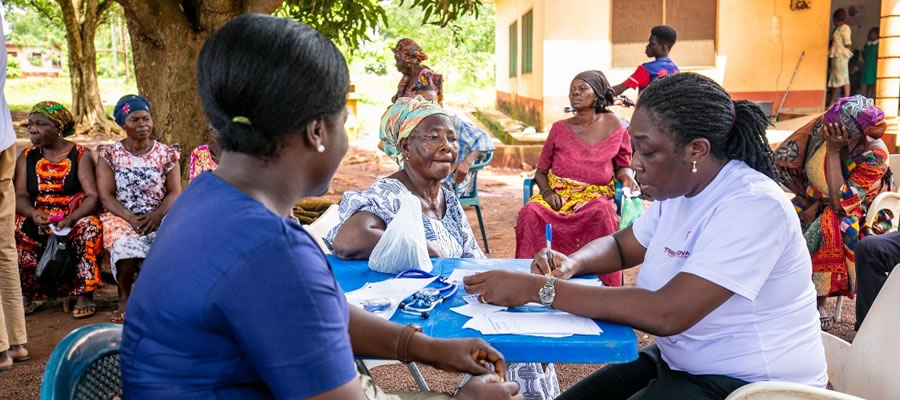

The population size, age and sex distribution of the district have a bearing on key socio-economic indicators including dependency ratio, employment, access to quality healthcare, education, basic infrastructure and other social amenities. Fertility, mortality and migration are the main drivers that account for changes in the population of the district. This chapter analyses the population size, age and sex structure, dependency ratio and migration patterns in the district. The chapter also presents information on fertility, mortality and the locality of residence (whether in rural or urban locality).
Population Size and Distribution
Table 2.1 shows the population distribution of the Akatsi North District by age, sex and sex ratio. The District is entirely rural and has a total population of 29,777 of which 45.9 percent are males while 54.1 percent are females. The age distribution of the population reveals that the population peaks at age group 0-4 years (13.1%), followed by 5-9 years age group (12.8%), after which the population tapers from age group 20-24 onwards. Males are in higher proportions compared to females in the age groups from age 0 to 24 years. The reverse is the case for the age groups from age 25 years and older. The sex ratio is 84.8 which, means that there are approximately 85 males in every 100 female population in the District. The total dependency ratio for the District is 56.4 and is higher for the males (94.6) than that of females (82.1).
Children ever born and survived
Table 2.3 presents information on children ever born and children surviving. It is observed that, out of the total number of 38,166 children ever born to 11,584 female population aged 12 years and older in the District, about 80.9 percent survived; meaning about 19.1 percent of the children died. Generally, the average number of children ever born and children surviving increase with increasing age.
Mortality
Mortality is defined in the 2010 PHC as all deaths that occurred in a household during the 12 months preceding the Census Night. It measures mortality rates on the responses to questions on “births and deaths in the last 12 months”. The Akatsi North District recorded a total of 557 deaths in the last 12 months (Table 2.4). Table 2.4 indicates that the District has a crude death rate of 18.7 per 1000 population which is quite higher than the regional average of 8.8 per 1000 population.
Age-Sex Structure
Information on age-sex structure is very important for effective planning and decision making. Data disaggregated by age and sex are crucial not only for demographic analysis of fertility, morbidity and mortality but also for planning purposes. The pyramid (Figure 2.1) shows the age-sex structure of the population of the Akatsi North District. The age structure shows a youthful population which is characteristic of most developing countries. The pyramid follows the expected pattern of reductions with advancing age and has a bell-shaped.
Migration
Information on fertility is essential in analysing the growth of a country’s population. Lifetime fertility is defined as the total number of live births that females age 12 years and older have ever had during their life time while current fertility refers to the number of live births that females 12-54 years and older have in the 12 months preceding the Census Night. Total Fertility Rate (TFR) is defined as the total number of births a woman would have by the end of her childbearing period if she were to pass through those years bearing children at the currently observed age-specific fertility rates. General Fertility Rate (GFR) is defined as the number of live births occurring during a specified period per 1,000 women aged between 15-49 while Crude Birth Rate (CBR) is defined as the number of births per 1,000 population during a specified period. Women were asked some questions to determine the total number of live births they had in their lifetime, children surviving and births in the past 12 months.
Table 2.2 shows that the Akatsi North District has a total fertility rate (TFR) of 4.1 which is higher than the regional average of 3.4. Besides, both GFR and CBR of the District (115.6 and 27.7 respectively) are higher as compared with that of the region (99.2 and 24.2 respectively). The high levels of TFR, GFR and CBR in the District could be as a result of low or non-use of contraceptives among females and males in preventing pregnancy.
Date Created : 11/17/2017 5:19:35 AM













 facebook
facebook
 twitter
twitter
 Youtube
Youtube
 +233 593 831 280
+233 593 831 280 0800 430 430
0800 430 430 GPS: GE-231-4383
GPS: GE-231-4383 info@ghanadistricts.com
info@ghanadistricts.com Box GP1044, Accra, Ghana
Box GP1044, Accra, Ghana